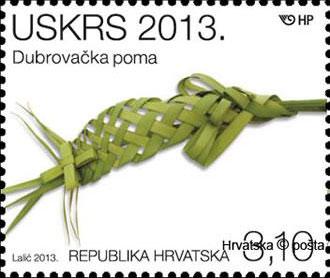Easter in Croatia
Pepelnica
Ash Wednesday
As in many western Christian churches, Ash Wednesday is the first day of Lent, a period of 40 days (not including Sundays, so technically 46 days) that precedes Easter Sunday. For Croatian Christians, this is a day of fast and abstinence as well as penance (of which ash is a symbol) and meditation.
The practice of receiving ashes is accompanied by the priest’s words: “Spomeni se, čovječe, da si prah i da ćeš se u prah pretvoriti.” (“Remember that you are dust, and to dust you shall return.”)
Some parts of Croatia have a custom of people washing their faces with flowers – usually violets (ljubičice) – and other plants on the morning of Palm Sunday, the Sunday before Easter. This tradition is related to celebrating spring, youth and new life. Young girls would collect spring flowers and put them in the family’s wash basin. Often the entire house would be decorated with spring flowers.
The faithful gather in churches with olive branches (maslinove grančice - most commonly, as Croatia is well-known for its olive trees) or palm branches (palmine grančice). In the areas where there are no olive or palm trees, any other type of branches is acceptable. These branches are blessed and brought back home.
In the past, people in Croatia would also take some of these blessed branches to their fields and stables. The branches are traditionally kept at home – usually next to crucifixes or pictures of saints, but also on windows or mirrors – even after they dry out, sometimes until the next year’s Palm Sunday, as a symbol and a reminder of their faith in Jesus.
The south of Croatia, especially the areas around the city of Dubrovnik, have a special tradition of making characteristically intertwined palm branches called pome, which is a local word in these areas, meaning palms.

Pome are made from two palm leaves and usually decorated with a cross on the top. Traditionally, pome were brought to churches for blessing only by children, so those families who didn’t have children – or whose children had already grown up – would give their pome to the children from the neighbourhood. Children were happy to get as many pome as possible as those who had them would receive two Easter eggs instead of just one on Easter Sunday.
Pome – just like any other “plain” branches – are traditionally never thrown away but rather buried into the ground or, more frequently, burned. Their ash is then used for the ceremony of ash receiving on the next Ash Wednesday.
The tradition of žudije, the guardians of the tomb of Christ, is typical for the region of Dalmatia. It begins on Holy Thursday (Veliki četvrtak) when the guardians start their guard by the altar, where typically a carefully decorated tomb is set. They regularly change shifts up until the Easter Vigil (Uskrsno bdijenje). Then at midnight, when the bell tolls at the beginning of the Holy Mass, they fall on the ground, to symbolise terror at the fact that Christ has been resurrected.
The beginning of this tradition dates back to the mid-19th century. Today, each part of Dalmatia has its own customs. Žudije are usually dressed as Romans, but sometimes also as sailors or they wear various traditional costumes. There are 12 guardians led by the commander called Juda as the 13th member. The name žudije is probably derived from Jews. Any young man who has received all the sacraments and is a decent member of the parish can become a žudija.
The parish of St. Elias (župa sv. Ilije) in Metković has the oldest tradition of žudije – they were established there in 1857.
In order to preserve this tradition, Susret žudija Dalmacije (Meeting of Žudije from Dalmatia) was held in 2001 in a small coastal town of Vodice, which attracted a large number of žudije from all over Dalmatia. This meeting was hosted by Vodice annually up until 2006, when it was decided that it will be hosted by a different parish every year to promote getting acquainted with their customs. As the initiator of this tradition, Vodice kept the honour of organizing this meeting every 6 years.
The name of this event has been changed several times, but since 2011, the meeting has been known as Festival žudija (Festival of Žudije).







